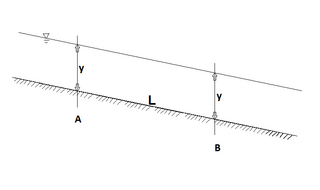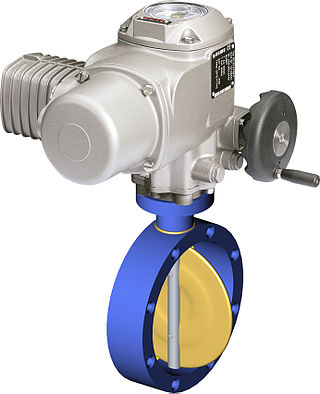
Hydraulics is a technology and applied science using engineering, chemistry, and other sciences involving the mechanical properties and use of liquids. At a very basic level, hydraulics is the liquid counterpart of pneumatics, which concerns gases. Fluid mechanics provides the theoretical foundation for hydraulics, which focuses on the applied engineering using the properties of fluids. In its fluid power applications, hydraulics is used for the generation, control, and transmission of power by the use of pressurized liquids. Hydraulic topics range through some parts of science and most of engineering modules, and cover concepts such as pipe flow, dam design, fluidics and fluid control circuitry. The principles of hydraulics are in use naturally in the human body within the vascular system and erectile tissue. Free surface hydraulics is the branch of hydraulics dealing with free surface flow, such as occurring in rivers, canals, lakes, estuaries and seas. Its sub-field open-channel flow studies the flow in open channels.

A shock absorber or damper is a mechanical or hydraulic device designed to absorb and damp shock impulses. It does this by converting the kinetic energy of the shock into another form of energy which is then dissipated. Most shock absorbers are a form of dashpot.

Pneumatics is a branch of engineering that makes use of gas or pressurized air.
An actuator is a component of a machine that is responsible for moving and controlling a mechanism or system, for example by opening a valve. In simple terms, it is a "mover".

Mechatronics engineering also called mechatronics, is an interdisciplinary branch of engineering that focuses on the integration of mechanical, electrical and electronic engineering systems, and also includes a combination of robotics, electronics, computer science, telecommunications, systems, control, and product engineering.

Fluid power is the use of fluids under pressure to generate, control, and transmit power. Fluid power is subdivided into hydraulics using a liquid such as mineral oil or water, and pneumatics using a gas such as air or other gases. Compressed-air and water-pressure systems were once used to transmit power from a central source to industrial users over extended geographic areas; fluid power systems today are usually within a single building or mobile machine.

Hydropneumatic suspension is a type of motor vehicle suspension system, designed by Paul Magès, invented by Citroën, and fitted to Citroën cars, as well as being used under licence by other car manufacturers, notably Rolls-Royce, Bmw 5-Series e34 Touring, Maserati and Peugeot. It was also used on Berliet trucks and has more recently been used on Mercedes-Benz cars, where it is known as Active Body Control. The Toyota Soarer UZZ32 "Limited" was fitted with a fully integrated four-wheel steering and a complex, computer-controlled hydraulic Toyota Active Control Suspension in 1991. Similar systems are also widely used on modern tanks and other large military vehicles. The suspension was referred to as fr:Suspension oléopneumatique in early literature, pointing to oil and air as its main components.
For fluid power, a working fluid is a gas or liquid that primarily transfers force, motion, or mechanical energy. In hydraulics, water or hydraulic fluid transfers force between hydraulic components such as hydraulic pumps, hydraulic cylinders, and hydraulic motors that are assembled into hydraulic machinery, hydraulic drive systems, etc. In pneumatics, the working fluid is air or another gas which transfers force between pneumatic components such as compressors, vacuum pumps, pneumatic cylinders, and pneumatic motors. In pneumatic systems, the working gas also stores energy because it is compressible.

Hydraulic machines use liquid fluid power to perform work. Heavy construction vehicles are a common example. In this type of machine, hydraulic fluid is pumped to various hydraulic motors and hydraulic cylinders throughout the machine and becomes pressurized according to the resistance present. The fluid is controlled directly or automatically by control valves and distributed through hoses, tubes, or pipes.

A pneumatic motor, or compressed air engine, is a type of motor which does mechanical work by expanding compressed air. Pneumatic motors generally convert the compressed air energy to mechanical work through either linear or rotary motion. Linear motion can come from either a diaphragm or piston actuator, while rotary motion is supplied by either a vane type air motor, piston air motor, air turbine or gear type motor.

Hydraulic head or piezometric head is a specific measurement of liquid pressure above a vertical datum.

A fluid coupling or hydraulic coupling is a hydrodynamic or 'hydrokinetic' device used to transmit rotating mechanical power. It has been used in automobile transmissions as an alternative to a mechanical clutch. It also has widespread application in marine and industrial machine drives, where variable speed operation and controlled start-up without shock loading of the power transmission system is essential.

Pneumatic cylinders are mechanical devices which use the power of compressed gas to produce a force in a reciprocating linear motion.
A control valve is a valve used to control fluid flow by varying the size of the flow passage as directed by a signal from a controller. This enables the direct control of flow rate and the consequential control of process quantities such as pressure, temperature, and liquid level.
Directional control valves (DCVs) are one of the most fundamental parts of hydraulic and pneumatic systems. DCVs allow fluid flow into different paths from one or more sources. DCVs will usually consist of a spool inside a cylinder which is mechanically or electrically actuated. The position of the spool restricts or permits flow, thus it controls the fluid flow.,
Electro-Hydrostatic actuators (EHAs), replace hydraulic systems with self-contained actuators operated solely by electrical power. EHAs eliminate the need for separate hydraulic pumps and tubing, because they include their own pump, simplifying system architectures and improving safety and reliability. This technology originally was developed for the aerospace industry but has since expanded into many other industries where hydraulic power is commonly used.
Fluid deforms continuously on the application of shear stress, no matter how much small is it. Fluid comprises both gases and liquid. The technique of using liquid for power transmission is called as hydraulics while which uses gases for power transmission is called Pneumatics. In most hydraulic systems, mineral oils will be used while in most pneumatic systems, atmospheric air will be used.

A rotary actuator is an actuator that produces a rotary motion or torque.

An oleo strut is a pneumatic air–oil hydraulic shock absorber used on the landing gear of most large aircraft and many smaller ones. This design cushions the impacts of landing and damps out vertical oscillations.
Simcenter Amesim is a commercial simulation software for the modeling and analysis of multi-domain systems. It is part of systems engineering domain and falls into the mechatronic engineering field.












